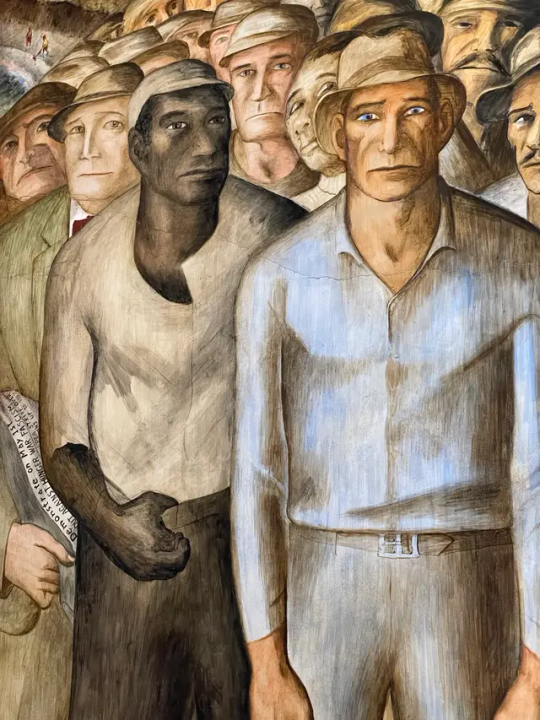#Agricultural Property Relief
Explore tagged Tumblr posts
Text
Farmers threaten to unleash 'buckets of s***' on Parliament | UK | News News Buzz
Angry farmers threaten to unleash ‘buckets full of s***’ on Parliament in huge tax protest. (Image: Getty) Farmers across the UK have reportedly voiced outrage over changes to inheritance tax announced in Rachel Reeves’ budget. Right-wing political website Guido Fawkes reported sources claiming that some farmers are threatening to dump “buckets full of s***” on Parliament as anger erupts…

View On WordPress
#Agricultural Property Relief#farmer strike#farmers against budget#farmers against Rachel Reeves#Farmers protest#farming protest#farming uk#Inheritance Tax#parliament protest#Rachel Reeves
0 notes
Text
Things Biden and the Democrats did, this week #14
April 12-19 2024
The Department of Commerce announced a deal with Samsung to help bring advanced semiconductor manufacturing and research and development to Texas. The deal will bring 45 billion dollars of investment to Texas to help build a research center in Taylor Texas and expand Samsung's Austin, Texas, semiconductor facility. The Biden Administration estimates this will create 21,000 new jobs. Since 1990 America has fallen from making nearly 40% of the world's semiconductor to just over 10% in 2020.
The Department of Energy announced it granted New York State $158 million to help support people making their homes more energy efficient. This is the first payment out of a $8.8 billion dollar program with 11 other states having already applied. The program will rebate Americans for improvements on their homes to lower energy usage. Americans could get as much as $8,000 off for installing a heat pump, as well as for improvements in insulation, wiring, and electrical panel. The program is expected to help save Americans $1 billion in electoral costs, and help create 50,000 new jobs.
The Department of Education began the formal process to make President Biden's new Student Loan Debt relief plan a reality. The Department published the first set of draft rules for the program. The rules will face 30 days of public comment before a second draft can be released. The Administration hopes the process can be finished by the Fall to bring debt relief to 30 million Americans, and totally eliminate the debt of 4 million former students. The Administration has already wiped out the debt of 4.3 million borrowers so far.
The Department of Agriculture announced a $1 billion dollar collaboration with USAID to buy American grown foods combat global hunger. Most of the money will go to traditional shelf stable goods distributed by USAID, like wheat, rice, sorghum, lentils, chickpeas, dry peas, vegetable oil, cornmeal, navy beans, pinto beans and kidney beans, while $50 million will go to a pilot program to see if USAID can expand what it normally gives to new products. The food aid will help feed people in Bangladesh, Burkina Faso, Burundi, Chad, Democratic Republic of the Congo, Djibouti, Ethiopia, Haiti, Kenya, Madagascar, Mali, Nigeria, Rwanda, South Sudan, Sudan, Tanzania, Uganda, and Yemen.
The Department of the Interior announced it's expanding four national wildlife refuges to protect 1.13 million wildlife habitat. The refuges are in New Mexico, North Carolina, and two in Texas. The Department also signed an order protecting parts of the Placitas area. The land is considered sacred by the Pueblos peoples of the area who have long lobbied for his protection. Security Deb Haaland the first Native American to serve as Interior Secretary and a Pueblo herself signed the order in her native New Mexico.
The Department of Labor announced new work place safety regulations about the safe amount of silica dust mine workers can be exposed to. The dust is known to cause scaring in the lungs often called black lung. It's estimated that the new regulations will save over 1,000 lives a year. The United Mine Workers have long fought for these changes and applauded the Biden Administration's actions.
The Biden Administration announced its progress in closing the racial wealth gap in America. Under President Biden the level of Black Unemployment is the lowest its ever been since it started being tracked in the 1970s, and the gap between white and black unemployment is the smallest its ever been as well. Black wealth is up 60% over where it was in 2019. The share of black owned businesses doubled between 2019 and 2022. New black businesses are being created at the fastest rate in 30 years. The Administration in 2021 Interagency Task Force to combat unfair house appraisals. Black homeowners regularly have their homes undervalued compared to whites who own comparable property. Since the Taskforce started the likelihood of such a gap has dropped by 40% and even disappeared in some states. 2023 represented a record breaking $76.2 billion in federal contracts going to small business owned by members of minority communities. This was 12% of federal contracts and the President aims to make it 15% for 2025.
The EPA announced (just now as I write this) that it plans to add PFAS, known as forever chemicals, to the Superfund law. This would require manufacturers to pay to clean up two PFAS, perfluorooctanoic acid and perfluorooctanesulfonic acid. This move to force manufacturers to cover the costs of PFAS clean up comes after last week's new rule on drinking water which will remove PFAS from the nation's drinking water.
Bonus:
President Biden met a Senior named Bob in Pennsylvania who is personally benefiting from The President's capping the price of insulin for Seniors at $35, and Biden let Bob know about a cap on prosecution drug payments for seniors that will cut Bob's drug bills by more than half.
#Thanks Biden#Joe Biden#jobs#Economy#student loan debt#Environment#PFAS#politics#US politics#health care
764 notes
·
View notes
Text

Ancient Roman Villa in Germany Yields Fragments of a Large Votive Monument
Excavations at the Hechingen-Stein villa complex have been ongoing since the 1980s.
Archaeologists working on the decades-long excavation of Hechingen-Stein, a Roman villa complex in southwestern Germany, have unearthed more than 100 fragments of a giant votive monument.
While the precise form of the dedication to the Roman gods remains unclear, the monument would have originally been built out of many stone blocks laid one atop the other. Archaeologists believe only a small number of the monument’s blocks have been found and it already appears larger than similar structures so far discovered in Raetia and Upper Germania, regions occupied by the Romans on and off from the 1st century C.E. through the 5th century C.E.
“The blocks are decorated with reliefs on all sides, showing ancient gods and figures from the associated legends,” said Klaus Kortüm, an archaeologist working through the Stuttgart branch of Germany’s national office for monument preservation. “Following Roman times, the monument was broken up into pieces, both large and small, and scattered. Only some parts of the figures are recognizable and these can only be identified using better-preserved examples.”
The votive monument, the likes of which served both a religious function and a means of social signaling in Roman society, gestures to the question that has concerned archaeologists ever since the villa and its grounds were discovered the late 1970s: who was the owner of this large and well-developed property?
t’s possible that clues will emerge through further analysis of the votive monument, given they often included inscribed details about the dedicator, the gods involved, and the reasons for building the offering.



The complex at Hechingen-Stein is an outlier in the more than 1,500 Roman farmhouses, known as villa rustica, that have been found in Baden-Württemberg state. For starters, it probably didn’t serve an agricultural function on account of the poor soil quality in the surrounding area. Furthermore, it is larger and more elaborate than other rural Roman properties and includes an encircling wall, a main building with a courtyard and rooms with undersoil heating, a temple, and two areas for bathing.
It’s believed the complex was abandoned as part of a planned withdrawal around the year 260 C.E. and the lack of onsite destruction together with the fact it has never been built upon has made “the complex a site of outstanding importance for archaeology in the state,” as the Roman Open Air Museum at Hechingen-Stein put it.
Accordingly, excavations at Hechingen-Stein have taken place almost every year since 1992, gradually revealing the buildings, grounds, and surrounding wall, which have been made accessible to the public.
Aside from hopefully uncovering more blocks, the plan for the votive monument is to create scaled-down replicas of the blocks using a 3D printer. These will be assembled into a miniature model which will be shown, along with the original stone blocks, at the museum.
By Richard Whiddington.

#Ancient Roman Villa in Germany Yields Fragments of a Large Votive Monument#Hechingen-Stein villa complex#ancient artifacts#archeology#archeolgst#history#history news#ancient history#ancient culture#ancient civilizations#roman history#roman empire#roman art#ancient art
19 notes
·
View notes
Text


California has become a test case of the suicide of the West. Never before has such a state, so rich in natural resources and endowed with such a bountiful human inheritance, self-destructed so rapidly.
How and why did California so utterly consume its unmatched natural and ancestral inheritance and end up as a warning to Western civilization of what might be in store for anyone who followed its nihilism?
The symptoms of the state’s suicide are indisputable.
Governor Gavin Newsom enjoyed a recent $98 billion budget surplus—gifted from multibillion-dollar federal COVID-19 subsidies, the highest income and gas taxes in the nation, and among the country’s steepest sales and property taxes.
Yet in a year, he turned it into a growing $45 billion budget deficit.
At a time of an over-regulated, overtaxed, and sputtering economy, Newsom spent lavishly on new entitlements, illegal immigrants, and untried and inefficient green projects.
Newsom was endowed with two of the wettest years in recent California history. Yet he and radical environmentalists squandered the water bounty—as snowmelts and runoff long designated for agricultural irrigation were drained from aqueducts and reservoirs to flow out to sea.
Newsom transferred millions of dollars designated by a voter referendum to build dams and aqueducts for water storage and instead blew up four historic dams on the Klamath River. For decades, these now-destroyed scenic lakes provided clean, green hydroelectric power, irrigation storage, flood control, and recreation.
California hosts one-third of the nation’s welfare recipients. Over a fifth of the population lives below the property line. Nearly half the nation’s homeless sleep on the streets of its major cities.
The state’s downtowns are dirty, dangerous, and increasingly abandoned by businesses—most recently Google—that cannot rely on a defunded and shackled police.
Newsom’s California has spent billions on homeless relief and subsidizing millions of new illegal migrant arrivals across the state’s porous southern border.
The result was predictably even more homeless and more illegal immigrants, all front-loaded onto the state’s already overtaxed and broken healthcare, housing, and welfare entitlements.
Newsome raised the minimum wage for fast-food workers to $22 an hour. The result was wage inflation rippling out to all service areas, unaffordable food for the poor, and massive shut-downs and bankruptcies of fast food outlets.
Twenty-seven percent of Californians were born outside of the United States. It is a minority-majority state. Yet California has long dropped unifying civic education, while the bankrupt state funds exploratory commissions to consider divisive racial reparations.
California’s universities are hotbeds of ethnic, religious, and racial chauvinism and infighting. State officials, however, did little as its campuses were plagued for months by rampant and violent anti-Semitism.
Almost nightly, the nation watches mass smash-and-grab attacks on California retail stores. Carjackers and thieves own the night. They are rarely caught, even more rarely arrested—and almost never convicted.
Currently, Newsom is fighting in the courts to stop the people’s constitutional right to place on the ballot initiatives to restore penalties for violent crime and theft.
Gas prices are the highest in the continental United States, given green mandate formulas and the nation’s highest, and still raising, gasoline taxes—and are scheduled to go well over $6 a gallon.
Yet its ossified roads and highways are among the nation’s most dangerous, as vast sums of transportation funding were siphoned off to the multibillion-dollar high-speed rail boondoggle.
The state imports almost all the costly vitals of modern life, mostly because it prohibits using California’s own vast petroleum, natural gas, timber, and mineral resources.
As California implodes, its embarrassed government turns to the irrelevant, if not ludicrous.
It now outlaws natural gas stoves in new homes. It is adding new income-based surcharges for those who dutifully pay their power bills—to help subsidize the 2.5 million Californians who simply default on their energy bill with impunity.
What happened to the once-beautiful California paradise?
Millions of productive but frustrated, overtaxed, and underserved middle-class residents have fled to low-crime, low-tax, and well-served red states in disgust
In turn, millions of illegal migrants have swarmed the state, given its sanctuary-city policies, refusal to enforce the law, and generous entitlements.
Meanwhile, a tiny coastal elite, empowered by $9 trillion in Silicon Valley market capitalization, fiddled while their state burned.
California became a medieval society of plutocratic barons, subsidized peasants, and a shrinking and fleeing middle class. It is now home to a few rich estates, subsidized apartments, and unaffordable middle-class houses.
California suffers from poorly ranked public schools—but brags about its prestigious private academies. Its highways are lethal—but it hosts the most private jets in the nation.
The fantasies of a protected enclave of Gavin Newsom, Nancy Pelosi, and the masters of the Silicon Valley universe have become the abject nightmares of everyone else.
In sum, a privileged Bay Area elite inherited a California paradise and turned it into purgatory.

31 notes
·
View notes
Text
The British government’s inheritance tax reforms aren’t about class warfare or filling the “black hole” in the country’s budget, they are about taking vital land off small and medium-sized family farms and handing it to mega-corporations.
It’s yet another piece of the Great Reset agenda, specifically the war on food.
A quick course for non-Brits who don’t know how our country works (and, indeed, the substantial number of Brits who have recently demonstrated they don’t know how their own country works):
Since 1984 working farms have been 100% exempt from paying inheritance tax under the “agricultural property relief” (APR) system.
The justification for this was that working farms are needed to produce the food we all eat, and since British farming families are generally asset-rich but cash-poor, charging inheritance tax on farmland might negatively impact farm output.
Keir Starmer’s government has just announced that, as of April 2026, they are scrapping the APR scheme.
This means anyone inheriting a working farm will now have to pay up to 20% of the value of the assets in tax, and since farmers operate on fine margins that will likely mean selling of parcels of land to raise money. Some farmers may be forced to sell all the land at once, since piece-meal buyers may be hard to find.
As you can imagine, the farmers are not happy about this. Nor is anyone who understands the potential implications.
7 notes
·
View notes
Text
There has been much of public debate relating to this over the last two days. Many people were unaware that farms are largely exempt from Inheritance Tax... and understandably, many think this is wrong.
Changes to Agricultural Property Relief and Business Property Relief mean that farms that are worth more than £1 million will now be subject to Inheritance Tax.
Very few viable food producing farms are worth less than £1 million, but their profit margins are very small. This will largely affect family run farms. When a farmer passes on the business to his children, many will not be able to afford to continue running the farm.
In addition to the tax changes, the UK Government's Agricultural spending remains frozen at the same rate it has been since 2014. Over the last five years, it is estimated that running costs of farms have increased by 44%. This might help you realise why so many family farms are now in turmoil!
If smaller farms are to survive, it will inevitably lead to increase in food prices... which will affect everybody in the country!
I intend to be at the farmers' rally in London on 19th November. If I am called-up to assist in security surrounding this event... I will still find a way to show my support!
8 notes
·
View notes
Text
On the 14th of Of October 1881 tragedy struck the Scottish Fishing fleet when one hundred and eighty-nine fishermen drowned off the south east coast.
Scotland is famous for its frequently wet and windy weather. It lies in the path of eastward-moving Atlantic depressions which bring wind and clouds throughout the year, and is frequently hit by windstorms during the autumn and winter.
A severe storm struck the southern coast of Scotland on 14th October 1881, leading to the Eyemouth fishing disaster or ‘Black Friday’ as some locals call it. The Edinburgh Evening News reported the storm as such......
A storm of extraordinary violence set in on Thursday night and raged for the greater part of yesterday all over the country, causing great destruction to property and loss of life. All telegraphic communication between Scotland and the Metropolis was broken down by the wreckage of the wires and in several parts of the country similar isolation has occurred. Hundreds of magnificent trees have been torn to pieces or uprooted and cast across the roads, rendering traffic impracticable. From all parts of the country floods and serious agricultural havoc are reported. Railway traffic, in consequence of the destruction of signal posts and wires, was carried on with difficulty and the drivers of express trains report that they could scarcely maintain their footing on the engines. Snow lies deep in the north and the lower ranges of the Grampians have also received a coating of snow.
To put it into scale, at the time of the disaster Eyemouth lost one in three of the adult male population. Many crews were made up of immediate and extended family members, so the distress and hardship caused by the loss of so many all at once was particularly devastating in such a close-knit community. An appeal for funds to alleviate the distress caused by the disaster was made around the country and £45,000 was collected.
A week after the storm, John Doull in the Fishery Office in Eyemouth was able to start drawing conclusions as to why so many boats and fishermen were lost in the storm and the effect their loss would have on the community. He wrote:
It appears that the principal causes of the great loss of life and property arose from the fishermen not seeing the land when running for it in the thick of the storm until they were too close inshore and were then unable to work their boats into port, or out to sea again in the face of the gale. Some of the boats had their sails blown away or rendered utterly useless and were tossed about at the mercy of the waves and ultimately thrown on shore and lost with all hands.
It is also well known that most of the boats carried their ballast of stones not properly secured and that some of those saved had a narrow escape from destruction owing to it being thrown about in the hold by the heavy labouring they were subjected to in the storm...
The town and trade of Eyemouth continues to wear a very depressed aspect and will do so for a long time to come owing to the loss of such a large number of its fishermen and the paralysing of its only industry.
Many of the Widows and Orphans and dependents who are sufferers from the disaster are already receiving relief from the fund now being contributed throughout the Country on their behalf, and it is gratifying to know that there is every likelihood of such a sum of money being raised as will meet their wants in the future.
A series of monuments along the coast remember the tragedy. The figures represent the women and children left behind by the disaster and are by sculptor Jill Watson, who was commissioned to design memorials representing the surviving widows and children from four of the communities affected by the disaster - Cove, St Abbs, Eyemouth and Burnmouth.
The figures show the anguish that the people in the fishing communities must have felt, and to me look a bit disturbing..........




25 notes
·
View notes
Text
I'm Back with another OC!!! This time it's an older member of the team and one that both me and @stinkass0 both love so much. I can't wait to get into it and hope y'all like him!
Meet my favorite fuckhead
Jack Donkey
Call Sign: Ass
Age: 38 (Born 2034)
Height: 5'11
Texan 🇺🇲
Dumbass
Preface
-Jack is part of the Special Ops Team in the year 2072. This team is composed of many different people from many different walks of life but with one thing keeping them together. They each have been victims of an extreme war against a large terrorist organization. They have been injured and have had to have parts of their bodies replaced with Bionic replacements that enhance their abilities and make them super soldiers. This team now travels by Helicarrier to provide relief to targets of the terrorist group, perform recon/gather Intel on the terrorist group, and attack the terrorist group in major ways.
Country Roads
Jack Shayne Donkey was born in El Paso, Texas. His family was very well off and owned a horse ranch where they would raise and rehabilitate horses and cattle. He grew up gentling wild horses and bonding with the horses that were staying on their Ranch. He was often called 'Horseboy' by his school friends because that's what he rode to school in and what he rode home. His best friend, Pepper, an Appaloosa that Jack himself had helped Birth. He did everything with her, rode her around the property, ate breakfast with her, and helped her through many illnesses. His mothers noticed his affinity towards horseback riding and signed him up for private training in equestrian. There, Jack excelled, he caught on quickly and was passing up many kids that were his age. He would come home after school every day and instead of homework, he would go practice for the next time he would have training with the instructor.
One Big Ass
As Jack grew older, his passion for equestrian riding only grew with him. He signed up for the Equestrian team at school and took many Agriculture classes. It was the summer before his Junior year when he competed in the 2050 FEI Jumping World Championships and the end of his Junior year when he made the US Olympic Team for Equestrian. He was officially pronounced the youngest Olympic Equestrian Competitor and he made it clear he was playing to win. With all the hustle of trying out for the Olympic team, Jack pushed aside his schooling and was barely scraping by. His moms instantly jumped on his case about slacking in school and only playing with his horse. They threatened his spot on the Olympic team if he didn't shape up and pass Highschool. Jack didn't worry too much and passed his senior year, not with the best grades but with the best memories. Jack had no downtime after graduation though, he needed to get to work both physically and mentally but also the paperwork. Again, without missing deadlines, he certified his spot on the team and flew to Aukland, New Zealand for the 2052 Olympic Games.
Summer Days; Drifting Away
The three weeks that Jack Donkey was in Aukland were the greatest. His event was one of the first to compete and Jack took home Gold for USA, making him the Youngest Olympic Gold Medalist in Equestrian. Jack had really made a name for himself and gained quite the fanclub for his looks. It was the day of the closing ceremony and Jack Donkey was seated to watch when the 2052 Olympics became the last. The one event that brought the globe together, no longer peacefully celebrated. The first terrorist attack occurred, and Jack had just missed the initial bombing. He instantly kicked it into high gear once the smoke had cleared. He raced to where the closing ceremony was occurring and started helping remove still living people from the wreckage. It was a gruesome sight and got worse when another batch of planes flew over the arena and sent more bombs, right where Jack was standing.
Adjusting
When Jack woke up, he was in a hospital bed being experimented on, having a needle poked into his arm. He looked down at where he was being poked and what he saw was a metal arm where his forearms should've been. He demanded to know what had happened and if Pepper was okay. She didn't make it and neither did most of the Olympians. It was a global cold war. Nobody was going to do anything and everybody wanted answers. That's where Jack and his new teammates came in. They were to receive excruciating training and work for an independent company to figure out who bombed the Olympics and many other places that night in repayment for his new arms. "Hell No" Jack stated many times, very clearly. He refused and refused, but strived to be set free from his hospital room, so he agreed and cooperated, under one condition of course, they got a cool ass boat. The company caved in and ordered a yacht while the team endured training. During this training, Jack requested many upgrades in his new arms. He wanted them to shoot fire, bullets, a lasso, and contain a full body shield. He was then asked where all of it would fit and he caved in with it shooting bullets, Having a collapsible riot shield, and retractable blades. This demanding and getting his was garnered him the Call Sign 'Ass' because he was as stubborn as one.
4 notes
·
View notes
Text

[Image of Coit Tower painting of striking workers, taken while I was in San Francisco.]
LETTERS FROM AN AMERICAN
December 8, 2023
HEATHER COX RICHARDSON
DEC 9, 2023
You all are in trouble, because I am home tonight from ten weeks on the road and am taking the night for myself, writing about one of the Very Cool Things I learned in my travels. I expect there will be more stories along these lines in the next several weeks.
Ninety years ago today, on Friday, December 8, 1933, in the first year of President Franklin Delano Roosevelt’s administration, the Advisory Committee to the Treasury on Fine Arts met for four hours in Washington, D.C., with museum directors from all over the country and leaders from the art world. For the past nine months, the administration had been building a “New Deal” for the American people, using the government to help ordinary Americans in the midst of the Great Depression.
Together with the Democrats in Congress, the administration had launched the Civilian Conservation Corps that put young men to work planting trees, fighting fires, and maintaining wilderness trails. The Federal Emergency Relief Administration provided work and cash relief for unemployed workers; the Agricultural Adjustment Administration boosted farm prices by reducing agricultural surpluses, while the Farm Credit Act made it easier for farmers to borrow. The Civil Works Administration put more than 4 million unemployed Americans to work building 44,000 miles of new roads, 1,000 miles of new water mains, and building or improving 4,000 schools.
Now it was time to help artists. Inspired by the 1920s public art movement in Mexico in which young artists were paid to decorate public buildings, FDR’s former classmate George Biddle suggested to the president that artists could be hired to “paint murals depicting the social ideals of the new administration and contemporary life on the walls of public buildings.”
This idea dovetailed with the goal of the administration to tap into the skills of ordinary Americans in rebuilding the country by making sure people had work. After all, FERA administrator Harry L. Hopkins said, artists needed “to eat just like other people.” He promised $1,039,000 to be disbursed by the Treasury “for the purpose of alleviating the distress of the American artists” while decorating public property with world-class art.
At the Washington, D.C., meeting, the attendees discussed how to “carry…forward the world of encouraging the fine arts as a function of the Federal Government.” Their first speaker was First Lady Eleanor Roosevelt, who “expressed her sympathy with the idea of the Government’s employing artists,” and all the other speakers followed suit. The following Monday, the Public Works of Art Project (PWAP) opened its doors, and artists lined up outside government offices to apply. By Saturday, December 16, artists were receiving checks. When the project ended four months later, 3,749 artists had been on the payroll, producing more than 15,000 paintings, sculptures, and public murals.
The pilot project for the PWAP was Coit Tower in San Francisco’s Telegraph Hill neighborhood, located in the city’s Pioneer Park. The 210-foot Art Deco tower of unpainted concrete had been completed and dedicated in honor of volunteer firefighters on October 8, 1933 (perhaps not coincidentally, the date of the Great Chicago Fire of 1871). When the building was finished, it had 3,691 square feet of blank concrete wall space.
By January 1934, thanks to the PWAP, twenty-six San Francisco artists and nineteen of their assistants were transforming that blank space into frescoes and murals depicting California life. Several of the artists had worked in Mexico with muralist Diego Rivera as part of the socially conscious mural movement of 1920s Mexico and adopted his techniques, creating frescoes in which the colors became part of the wall as they dried. To keep the colors at Coit Tower uniform, one artist-assistant ground the color pigments for all the different frescoes.
But while they admired Rivera’s art, the New Deal artists, for the most part, focused not on revolution, as he did, but on the possibilities of the country’s new approach to government. Roosevelt was backing artists, and they backed him, painting not about revolution but about restoring healthy social and economic conditions in the United States.
By the time the PWAP got under way, the exciting artistic experiments of the early twentieth century that had brought Picasso’s cubism, for example, had begun to seem foreign and alienating, and artists had begun to turn toward representational art in a national style. The government’s requirement that the public art be about the “American scene” in American style for American people built on that shift. Artists in the PWAP painted either as “Regionalists,” who painted rural America, or “Social Realists,” who painted the cities. The Regionalists tended to celebrate the nation, while Social Realists—most of whom came from New York City—tended to critique it, but both groups found intelligence, power, and beauty in the ordinary people and the ordinary scenes they painted.
Coit Tower showed San Francisco’s people: striking workers, farmers, cowboys, travelers reading newspapers, news stenographers, chauffeurs, a rich man being held up at gunpoint, car accidents. People of color and women were underrepresented but not entirely ignored in this celebration of the possibilities of American life under the administration's new policies (one mural had an oil can in a corner to illustrate the government oiling the machinery of the economy for the mechanics in the next panel).
The murals in Coit Tower, and the PWAP that supported them, were such a roaring success that the federal government would shortly launch four more projects to fund artists (including writers), most famously under the Works Progress Administration that operated from 1935 to 1942. Although to a modern eye, many of the fine artists’ depictions of Indigenous Americans and racial and gender minorities are eye-poppingly racist, these colorful presentations of the lives and histories of ordinary Americans that decorated libraries, schools, courthouses, bathhouses, and post offices, honoring community and hard work—and, in the edgier paintings, jabbing at stockbrokers, bankers, and industrialists—celebrated a hopeful, new, progressive America.
For many Americans, who had never had access to fine art and were astonished to see fine art in local buildings, the medium was its own message: they realized their neighbors had talent they had never imagined.
President Joe Biden has deliberately echoed FDR’s policies of the New Deal in his economic program, promising to build the economy from the middle out and the bottom up, even as Republicans have insisted the only way to build the economy is to concentrate wealth on the “supply side” by cutting taxes. Today, there was more evidence that Biden’s policies are paying off for ordinary Americans. The November jobs report showed the economy added almost 200,000 more jobs in November, making the total since Biden took office more than 14 million, while the unemployment rate has stayed below 4% for 22 months in a row and wage growth is strong.
As Harvard professor Jason Furman notes, the U.S. is now 2 million jobs and 2 million employed above the pre-pandemic projections of the Congressional Budget Office. Dan Shafer of The Recombobulation Area observed, “If these numbers were happening during a Republican presidency, the usual business community folks would be celebrating in the streets. But when there’s a D next to the president’s name, it’s tumbleweeds.” Today, on the Fox News Channel, personality Maria Bartiromo noted that “the economy is a lot stronger than anyone understands.”
The president also echoed the New Deal’s promotion of internal improvements today when he announced an investment of $8.2 billion in new funding for ten major passenger rail projects across the country to deliver the nation’s first high-speed rail projects. High-speed rail between California and Nevada, serving more than 11 million people annually; Los Angeles and San Francisco; and the Eastern Corridor, will create tens of thousands of union jobs, build communities, and promote climate-friendly transportation options.
In a speech in Las Vegas, Nevada, announcing the rail plan, Biden called out his predecessor, who “always talked about infrastructure week. Four years of infrastructure week, but it failed. He failed,” Biden said. “On my watch, instead of having infrastructure week, America is having infrastructure decade.”
“Trump just talks the talk. We walk the walk,” he said. “Look. He likes to say America is a failing nation. Frankly, he doesn’t know what the hell he’s talking about. I see shovels in the ground, cranes in the sky, people hard at work rebuilding America together.”
LETTERS FROM AN AMERICAN
HEATHER COX RICHARDSON
#PWAP#artists#FDR#Eleanor Roosevelt#Letters From An American#Heather Cox Richardson#The New Deal#jobs#the economy#Biden Administration accomplishments
7 notes
·
View notes
Text

Alt: “Israeli legal rights group issues warning ahead of expected rain. Tania Hary, executive director at Gisha – Legal Center for Freedom of Movement, has said on X that with rain expected in Gaza in the next few days, the lack of sewage treatment is ‘terrifying.’ UNRWA’s Gaza chief had warned earlier that with no fuel being allowed into the besieged coastal enclave, sewage is not being pumped away from homes and waste is not being collected. Thomas White called it a “serious threat to public health”.

Alt: “EU supports ‘immediate pauses’ in Gaza: Borrell. The bloc’s top diplomat made the comment during a news conference following a meeting of foreign ministers in Brussels. The EU is calling for “immediate pauses and humanitarian corridors to be established in order to face the dire situation of the people in Gaza.”Reporting from Brussels, Al Jazeera’s Paul Brennan said the statement is an “incremental” shift from the bloc’s earlier appeal, which called for pauses but did not use the term “immediate”. Still, he said, the bloc has not called for an all out ceasefire, despite pressure from some members. Borrell also said he was traveling to Israel and the occupied Palestinian territories.”


Alt: “More from Gaza health ministry’s daily update. Gaza health ministry’s deputy director general Ismail al-Thawabta just gave the latest updates. Here’s what he said. Ten people – “kids, babies, patients and wounded” – were unable to be rescued at al-Shifa hospital due to operation rooms being shuttered from lack of fuel. If fuel shortage causes communications and internet black, which is projected to happen on Thursday, “all the crimes of Israel will be hidden from the world” and will move the humanitarian crisis from “bad to worse”. Fuel must be allowed into Gaza and Rafah crossing with Egypt must be fully opened. Israel and the international community – particularly the United States – are fully responsible for “crimes against civilians”. The fighting has also destroyed 41,120 residential properties; 94 government headquarters; 71 mosques destroyed; and 253 schools have been damaged. There has been $181m in direct agricultural losses, with 25 percent of agricultural farms destroyed.”


Alt: “‘All primary care for pregnant women has been lost’ Dr Haya Hijazi, who works at al-Hilo Hospital in Gaza City, has said that the collapse of the health system has meant there are no prenatal, neonatal or postpartum services catering to pregnant women, new mothers and newborns. UNFPA, the United Nations sexual and reproductive health agency, said that Gaza is home to 50,000 pregnant women.”
“It also said: 70 percent of those killed and injured so far are women and children. 5,500 women are due to give birth in the coming month – more than 180 births per day. Fuel, medicines, blood supply and other essentials for hospitals are running out. Two truckloads of Inter-agency Reproductive Health Kits have arrived in Gaza containing individual clean delivery kits and supplies and equipment for emergency obstetric care, including anesthesia and supplies for cesarean sections. Some 238 attacks against health care have been reported in the occupied Palestinian territories since the beginning of the hostilities, killing 517 people, according to WHO.”

Alt: “More from UNRWA’s Gaza chief. Thomas White said: “This morning, two of our main water distribution contractors ceased working – they simply ran out of fuel – which will deny 200,000 people potable water.”We earlier reported White’s warning that operations in Gaza by the United Nations Relief and Works Agency for Palestine Refugees (UNRWA) would shut down within two days due to fuel shortages. Israel has not allowed fuel to enter the Gaza Strip since before October 7. Earlier on Monday, the health ministry said all hospitals in the northern Gaza Strip had stopped functioning as a result of the impact of fuel shortages and intense ongoing fighting.”

Alt: “Al-Ahli now the ‘only hospital in all of Gaza City’: Doctor. Surgeon Ghassan Abu Sitta spoke to Al Jazeera from al-Ahli Hospital, which he said was now the only operating hospital in all of Gaza City after al-Shifa and al-Quds were forced to almost completely close. “Ever since the collapse of al-Shifa Hospital, we have become the only functioning Hospital in Gaza City,” he said. “If you recall, this is the hospital that was targeted initially by the Israelis at the beginning of the war and so parts of the hospital were damaged,” he said, referring to the October 17 blast at the hospital. Israel has denied it was behind that explosion, which Palestinian health officials said killed over 470 people.”

Alt: “Al-Quds hospital under ‘intense gunfire: Red Crescent. The Palestine Red Crescent says that Israeli military vehicles continue to surround the building, trapping patients and injured people, who have no food, water or power.”

Alt: “Doha denounces Israeli shelling of Qatari organisation in Gaza. Qatar has condemned the Israeli shelling of the Gaza Reconstruction Committee, calling it “a gross violation of international law and an extension of the Israeli modus operandi of targeting civilians and civilian infrastructure”. The foreign ministry called shelling the Gaza-based organisation is “an extension of Israel’s policy to target humans, especially since this committee works on alleviating the plight of Gaza’s population, which has been suffering from the long siege and ongoing aggression”. The ministry also demanded that Israel end its “false justifications” and the spread of “misinformation” that leads to the targeting of civilians and civilian installations.”
Sources at AlJazeera, Check out further updates there too.
4 notes
·
View notes
Text
Green Coffee Beans and Gut Health: Exploring the Connection
When we think of coffee, we usually picture a dark, aromatic beverage that provides us with an energy boost. However, there is another side to coffee that is gaining attention in the health world - green coffee beans. Unlike their roasted counterparts, green coffee beans are unroasted and contain higher levels of beneficial compounds. In recent years, researchers have been exploring the potential impact of green coffee beans on gut health and overall well-being.
The Composition of Green Coffee Beans
Green coffee beans are rich in antioxidants, particularly chlorogenic acids. These natural compounds have been linked to various health benefits, including improved heart health, weight management, and reduced inflammation. Additionally, green coffee beans contain a small amount of caffeine, which can have stimulating effects on the central nervous system.
Gut Health and its Importance
The gut plays a crucial role in our overall health and well-being. It houses trillions of bacteria, collectively known as the gut microbiota, which help with digestion, nutrient absorption, and immune function. A healthy gut microbiota is associated with a strong immune system, improved mental health, and even a reduced risk of chronic diseases.
The Potential Impact on Gut Health
Emerging research suggests that green coffee beans may have a positive impact on gut health. Some studies have shown that chlorogenic acids found in green coffee beans can act as prebiotics, which means they serve as food for beneficial gut bacteria. By promoting the growth of these friendly microbes, green coffee beans may help support a healthy gut microbiota.

In addition to its prebiotic properties, green coffee beans may also possess antimicrobial effects. A study published in the Journal of Agricultural and Food Chemistry found that green coffee extract exhibited antimicrobial activity against various harmful bacteria. This suggests that consuming green coffee beans may help maintain a balanced microbial environment in the gut.
Potential Benefits for Digestion
Improved gut health can lead to better digestion and nutrient absorption. The prebiotic properties of green coffee beans can help nourish the beneficial bacteria in the gut, leading to a more efficient digestion process. Furthermore, the presence of caffeine in green coffee beans may stimulate bowel movements, providing relief for individuals experiencing constipation.
Considerations and Precautions
While green coffee beans show promise in supporting gut health, it is essential to approach their consumption with caution. The caffeine content in green coffee beans may have stimulating effects on the nervous system, which can lead to insomnia, increased heart rate, and anxiety in sensitive individuals. Moreover, excessive consumption of green coffee beans may cause digestive disturbances, such as stomach upset or diarrhea.
It is always advisable to consult with a healthcare professional before incorporating green coffee beans into your diet, especially if you have any existing health conditions or are taking medications.

Incorporating Green Coffee Beans into Your Diet
If you're interested in reaping the potential benefits of green coffee beans for gut health, there are a few ways to incorporate them into your diet:
Green Coffee Bean Extract: Supplements containing green coffee bean extract are available in the market. Follow the recommended dosage instructions and look for reputable brands.
Green Coffee Bean Tea: Brew green coffee beans in hot water to create a flavorful and potentially beneficial tea. Adjust the steeping time to your taste preferences.
Green Coffee Bean Powder: Ground green coffee beans can be added to smoothies, homemade energy bars, or baked goods for a nutritional boost.
Remember, moderation is key when incorporating any new food or supplement into your diet. Start with small amounts and observe how your body responds.
Final Thoughts
While green coffee beans are not as widely known as their roasted counterparts, they offer a potential pathway to improve gut health. With their rich antioxidant content and prebiotic properties, green coffee beans may contribute to a healthy gut microbiota, leading to improved digestion and overall well-being. As with any dietary change, it is best to consult with a healthcare professional before making significant adjustments to your routine. By considering the potential benefits and taking necessary precautions, you can explore the connection between green coffee beans and gut health.

Source:
#GreenCoffeeBeans#OrganicBeans#SustainableCoffee#EthicallySourced#FairTradeBeans#SpecialtyCoffee#SingleOrigin#ArtisanalBeans#RoastYourOwn#CoffeeLovers#GreenCoffeeLife#EcoFriendlyBeans#HealthyLiving#BeanToCup#GreenCoffeeBenefits#GreenBeanRevolution#MorningBrew#GreenCoffeeAddict#HomeRoasting#NaturalEnergy
4 notes
·
View notes
Text
Been asked to repeat this for @msclaritea.
William Hurst (1787 - 1844), unlike Wanda's relatives who were agricultural labourers and very poor, was a solidly middle class son of a major inkeeper (William Hurst and his wife Mary nee Thompson)and property owner, who could trace his family history in the area back to at least to the 1600's. Working for a number of firms in his lifetime he built or designed many properties almost all in Yorkshire and none in the south. In fact none south of Rotherham. In the 1841 census he was living in one of the best streets in Doncaster and employed a groom and three servants. He owned a number of houses which were willed to his wife after his death. While he did create a design for the remodelling of Firbeck Hall (cult HQ in the area according to the swamp) it was only a design and was not what was finally built, suggesting that he did not do the work there - it does not appear in his RIBA entry. The firm he worked for has no connection with Robert Causwell who did remodel the hall in 1935.
As for Wanda's ancestors living near the Isle of Wight. They lived around 20 miles (and a boat trip) from the island. 20 miles is an area which covers the coastline from Littlehampton to Chichester and includes the major centres of population in Hampshire at the time (1800), Winchester and Petersfield. Literally hundereds of thousands of people lived in this arc of land including at least one branch of my family.
Wanda’s parents were Fredrick Howard VENTHAM and Gladys Frances HOLTHAM. Frederick was born in 1910 in Lewes, Sussex.
Fredrick’s parents were Fredrick William VENTHAM (1875-1952) and Mabel WATERS (1876-1971) Fredrick was born in Awbridge, Hampshire (a tiny parish near Mottisfont) was a coachman for most of his life and after he moved to Lewes and then Brighton he started hiring out cars.
Fredrick William’s parents were William VENTHAM (1849-1928) and Sarah Jane HURST (1851-1932) William was born in Awbridge and was an agricultural labourer all his life.
Sarah Jane’s parents were William HURST (1812-1898) and Ann JONES again they were born in the Mossisfont/Michelmersh area. William was an agricultural labourer all his life
William’s parents were Isaac HURST(1770-1851) and Mary MASON(1770-1851). Both from the Mottisfont/Michelmersh area Like their descendants they worked the land. They were extremely poor for a while Isaac rented some land and a tiny house but his children went into service very young (one of his daughters was 10 and working for another labourer) and after he died his widow relied on parish relief. The Ventham’s living in the area were slightly more prosperous as a few of them paid hearth tax.
There are no connections with Doncaster or Yorkshire and like most of their contemporaries they were working class agricultural workers. The only time they were mentioned in documents other than baptism, marriage & burial records were when they claimed poor relief or were fined for selling cider without permission. It was only in the 20th century that they moved into the lower middle classes. There is no mystery about them, most were barely literate and they went through the usual (for the 18th and 19th century) pain of losing many children to infectious diseases which are all too treatable now.
7 notes
·
View notes
Text
Exploring Farm Status: Requirements and Application Process in British Columbia
In British Columbia, the classification of land as a farm for assessment and tax purposes is governed by Section 23 of the Assessment Act and B.C. Reg. 411/95, known as the Classification of Land as a Farm Regulation, collectively referred to as the "Farm Class Legislation." This legislation lays down the essential conditions that must be met for land to obtain farm classification, providing owners with certain tax benefits and exemptions.
Participation in the farm classification program is voluntary. Landowners who wish to classify all or part of their property as a farm need to apply to the local assessor using the appropriate prescribed application forms. These forms include the General Application for Farm Classification and the Retired Farmer's Dwelling Land Application, catering to different farm-related scenarios.
To ensure compliance with the Farm Class Regulation, farm applications and any applicable lease agreements must be submitted to BC Assessment no later than October 31 for the following taxation year. This deadline allows the authorities to properly evaluate and assess the farm's eligibility for classification and apply the relevant tax incentives in a timely manner.
It's essential to note that in 2020 and 2021, the province introduced Exceptional Circumstances Orders specifically waiving the income requirements for the 2021 and 2022 Assessment Roll/Tax years. This measure was aimed at providing temporary relief to farmers during challenging times. However, starting with the 2023 Assessment Roll, BC Assessment has reverted to the standard practice, and the Classification of Land as a Farm Regulation's criteria will once again apply.
For farms due for an income review, a mail-out request was sent to prompt the submission of income details for either the 2020 or 2021 calendar years. If the reported income meets the income threshold based on the farm's size, the property may qualify for farm classification for the 2023 Assessment Roll, provided all other relevant criteria are met.
Understanding the classification of land as a farm and the application process is crucial for landowners seeking to benefit from the farm class designation. BC Assessment offers helpful resources to guide individuals through this process, ensuring they are well-informed about the requirements and the steps they need to take.
In conclusion, farm classification in British Columbia offers landowners significant advantages, but it is vital to adhere to the Farm Class Legislation and submit the required applications on time. By doing so, farmers can enjoy tax benefits while contributing to the growth and prosperity of the agricultural sector in the province.
Take Control of Your Farm Classification Today!
Are you a landowner in British Columbia looking to secure farm classification for your property and unlock the many benefits it brings? Do you find the process confusing or need more clarity on the requirements? Look no further – Farm Assessment Consultancy is here to assist you every step of the way!
Our team of expert consultants specializes in navigating the intricacies of farm classification regulations, ensuring that you make the most of this voluntary program. Whether you're a seasoned farmer or new to the agricultural landscape, we are dedicated to helping you achieve the farm class designation and all the tax advantages it offers.
Don't let uncertainty or unanswered questions hold you back. Our consultants possess an in-depth understanding of the Farm Class Legislation, and they're ready to provide personalized guidance tailored to your unique situation.
Take action now and reach out to Farm Assessment Consultancy for professional support and assistance. Visit our website at https://farmassessment.com/ or find us at https://goo.gl/maps/VkH1bFg9v4f3bh3Z7. Empower yourself with knowledge and expertise to maximize the potential of your farm property.
Seize this opportunity to elevate your land's classification and secure the financial benefits you deserve. Contact Farm Assessment Consultancy today and embark on a path towards a brighter, more prosperous future for your farm!
2 notes
·
View notes
Text
I’ve started a column. It is published in my neighborhood’s newsletter. It’s called Conservationists’ Corner. This is the second dispatch.
Conservationists’ Corner
Spring is upon us, and those of us who love nature, and being out in it, are breathing a sigh of relief.
For many of us, planting is what we look forward to the most. It’s fun to imagine how beautiful our gardens will look in full bloom, buzzing with life as bees, butterflies, birds, and all of the blessed critters of Weslake flutter about. There are a lot of qualities that make a plant a great addition to your yard. It might bloom when other plants aren’t, providing color for us and food for friendly pollinators. It might be well suited to grow in that shady corner where other flora hasn’t. It might be a native that hosts an endangered butterfly you hope your grandkids will see. These are all fabulous reasons to select plants for your garden.
In this season’s column, we will discuss the differences between exotic and native species, the importance of adding native species to our gardens, and some simple things we can do to encourage beloved beneficial insects like butterflies, bees, and lightning bugs!
What is a native plant?
Native plants are plants that evolved in their specific region, and are planted and grow there presently. They thrive in the the environment they’re in, and they serve important functions in the health and prosperity of the other native flora (plants) and fauna (animals) they live among by providing essential food and habitat. So the definition of a native plant refers to where it is as much as what it is. Many of our favorite plants are native plants, like hydrangea, dogwood, redbud, columbine, magnolia, milkweed (host plant for the endangered monarch and other butterflies) and so many more!
All plants are native to somewhere, so what happens when a plant is exported from its original evolutionary home? It becomes an exotic species, and a few things can happen in that case.
Exotic species: high maintenance
Some exotic species are poorly suited to their new home, and without lots of effort and expense, they struggle and die. They might not be suited to the type of soil here, needing different nutrient ratios, or drainage qualities. They might need more or less water than our climate provides. They might need cooler daytime temperatures in summer, or warmer winters to survive another year. A frugal or busy gardener avoids these plants.
Exotic species: Naturalized
If an exotic species thrives where it’s planted, but doesn’t reproduce so vigorously that it crowds out native species is considered Naturalized. It is a good guest, adding beauty and novelty. Naturalized species don’t play an important role in the ecosystem, but they don’t harm it either.
Exotic species: Invasive
Finally, we have dreaded invasive species. These plants thrive in their new environment, and they reproduce so vigorously, that they crowd out and ultimately lead to the extinction of native species. They are terrible guests, and we very much regret bringing them to the continental US. Invasive species also have an economic impact, costing the US over $26 billion a year in agricultural and industrial losses (according to the USDA).
In our beloved ******* subdivision, we unfortunately have a real invasive species problem on our hands. If you look closely, you will notice that invasive bush honeysuckle (imported originally from Japan) is everywhere we think of as woods. You can see them easily in early spring, because they turn green weeks before anything else does. They are crowding out our native plants, shrubs, and small trees to the point of ecological collapse. If you are interested in removing them from your property, but need some help identifying them and planning a course of action, feel free to contact me at *******@gmail.com. I will either meet with you or send resources your way. Two other dangerous invasive species our neighborhood is plagued by are winter creeper and invasive grape vine. These are both vigorous vines which climb and smother trees. Everywhere woods are present in our neighborhood (and sadly our region) you will see huge tangles of vines hanging in the canopy. If you look more closely you will notice a startling amount of fallen limbs, trees broken in half, and trees completely fallen. Our woods are being killed by these vines, and left to run their course, they leave behind only tangles of invasive vines and honeysuckle where our once majestic native woods once thrived. Again, if you need help identifying and removing these harmful invasives on your property, email me at *********@gmail.com, and we can come up with a plan or at least get you pointed in the right direction.
More lightning bugs!
Many of us fondly remember the magic of fireflies flashing in the summer dusk. These days we see a few in the lawn and we wonder where the rest have gone. The reason they are so few is because we’ve encroached on their habitat. They live, reproduce, feed, and sleep on the ground, in the grass. When we mow often, and with a low blade, we are killing them. When we use pesticides and herbicides on our lawn, we are poisoning them. When we have outdoor lights on when we don’t need them, we make it much harder for them to mate (they find each other by flashing their lights). So if we want to enjoy fireflies again, we can mow less often, and set our blade to a higher position. We can refrain from treating our lawns with herbicides and pesticides, and we can use fewer outdoor lights. Our city’s code requires us to keep our lawns shorter than 8”. Thats pretty high (I’d suggest maintaining a shorter front yard to keep the peace with neighbors!) so we can follow the rules while increasing habitat for these majestic beings! There’s room for both!
2 notes
·
View notes
Text
AG Organica Clove Oil Manufacturer & Wholesale Supplier: Premium Quality & Trustworthy Sourcing
In the dynamic world of essential oils, AG Organica has established itself as a prominent manufacturer and wholesale supplier of clove oil, known for its purity, potency, and therapeutic benefits. Clove oil, extracted from the buds of the clove tree (Syzygium aromaticum), is one of the most versatile essential oils used across industries such as healthcare, aromatherapy, cosmetics, and food production. AG Organica, with its unwavering commitment to quality, sustainability, and customer satisfaction, stands as a trusted partner for businesses seeking high-quality clove oil in bulk.

The Essence of Clove Oil
Clove oil is derived from the flower buds of the clove tree through a process of steam distillation. Known for its distinctive spicy aroma and powerful medicinal properties, clove oil has been used for centuries in traditional medicine, especially in Ayurveda and Chinese medicine. The active compound in clove oil, eugenol, is responsible for its antiseptic, analgesic, and anti-inflammatory properties. This makes it a popular ingredient in oral care products, pain relief ointments, and personal care formulations.
Clove oil is not only valued for its medicinal uses but also for its ability to enhance the flavor and aroma of food and beverages. Additionally, it is widely used in aromatherapy to promote relaxation, alleviate stress, and boost mental clarity.
AG Organica: Leaders in Clove Oil Production
AG Organica is a leading clove oil manufacturer with a reputation for delivering high-grade products to clients worldwide. The company adheres to stringent quality control measures and sustainable sourcing practices to ensure that every drop of clove oil meets the highest industry standards. Here’s why AG Organica is the go-to choice for businesses looking for bulk clove oil supplies:
1. Sustainable Sourcing
AG Organica sources its clove buds from organic, sustainable farms, ensuring that the raw material is of the finest quality. By working closely with farmers who practice eco-friendly agriculture, the company minimizes environmental impact while supporting local farming communities. This commitment to sustainability extends through the entire production process, from sourcing to packaging.
2. State-of-the-Art Manufacturing
As a leading clove oil manufacturer, AG Organica uses advanced steam distillation techniques to extract the purest and most potent form of clove oil. The company employs cutting-edge technology and equipment to maintain the integrity of the oil’s active compounds. This ensures that the final product is rich in eugenol and free from contaminants, making it suitable for both industrial and therapeutic applications.
3. Stringent Quality Control
AG Organica takes quality control very seriously, conducting multiple tests and analyses to guarantee the consistency, purity, and safety of its products. Every batch of clove oil undergoes rigorous testing to ensure that it meets international standards for essential oils. This attention to detail has earned the company numerous certifications, including GMP, ISO, and USDA Organic.
4. Wholesale Supplier of Clove Oil
With a global distribution network, AG Organica has become a trusted wholesale supplier of clove oil. The company caters to businesses of all sizes, from small cosmetic brands to large-scale manufacturers. By offering flexible bulk packaging options, AG Organica ensures that its clients receive the right quantity of oil to meet their specific production needs. The company’s ability to supply clove oil in large volumes without compromising on quality has made it a preferred partner for businesses across multiple industries.

Why Choose AG Organica as Your Clove Oil Supplier?
Whether you're in the business of aromatherapy, cosmetics, or food production, choosing the right clove oil supplier is crucial to the success of your products. AG Organica stands out for several reasons:
1. Commitment to Purity
AG Organica’s clove oil is 100% pure, free from synthetic additives, chemicals, or adulterants. This makes it ideal for use in sensitive applications, such as skincare and healthcare products. The oil’s high eugenol content ensures maximum therapeutic benefits, making it a powerful ingredient for pain relief, antimicrobial applications, and inflammation reduction.
2. Customized Solutions
Every business has unique needs, and AG Organica understands this well. The company offers customized solutions for its clients, including private labeling and bespoke formulations. Whether you need a specific concentration of clove oil or a tailored blend of essential oils, AG Organica has the expertise and flexibility to meet your demands.
3. Competitive Pricing
Despite its premium quality, AG Organica’s clove oil is competitively priced. As a wholesale supplier, the company offers attractive pricing for bulk orders, ensuring that businesses can maintain their profit margins while still offering high-quality products to their customers.
4. Global Reach
AG Organica’s extensive distribution network allows it to serve clients worldwide. Whether you're based in the United States, Europe, Asia, or elsewhere, AG Organica ensures timely delivery and seamless customer service, regardless of your location.
Applications of Clove Oil
As a versatile essential oil, clove oil finds application in various sectors. Here are some of the key uses of clove oil that AG Organica supplies:
1. Healthcare and Medicine
Clove oil’s analgesic and antiseptic properties make it an essential ingredient in dental care products, such as toothpaste, mouthwash, and pain relief gels. Its anti-inflammatory effects are also used in natural remedies for muscle pain, arthritis, and respiratory issues.
2. Aromatherapy
In the world of aromatherapy, clove oil is cherished for its warm, spicy scent, which helps reduce stress and anxiety. It is often used in diffusers, candles, and massage oils to promote relaxation and mental clarity.
3. Cosmetics and Personal Care
Clove oil is a popular ingredient in skincare and cosmetic products due to its antibacterial and anti-inflammatory properties. It is found in formulations designed to treat acne, reduce inflammation, and improve skin texture. In addition, clove oil is used in hair care products to promote healthy scalp conditions.
4. Food and Beverage Industry
Clove oil is widely used as a flavoring agent in the food and beverage industry, particularly in baked goods, candies, and sauces. Its spicy, aromatic flavor enhances the taste of various dishes while also providing health benefits such as improved digestion and immune support.

"AG Organica Clove Oil Manufacturer & Wholesale Supplier"
Conclusion
In an industry where quality and purity are paramount, AG Organica stands tall as a trusted manufacturer and wholesale supplier of clove oil. With its commitment to sustainable sourcing, advanced manufacturing processes, and rigorous quality control, the company has earned the trust of businesses across the globe. Whether you’re looking for premium clove oil for medicinal, cosmetic, or food applications, AG Organica provides the best-in-class solutions to meet your needs.
Choosing AG Organica as your clove oil supplier means you’re not just investing in a product, but in a partnership rooted in quality, sustainability, and customer satisfaction.
https://www.pureoilsindia.com/product/clove-leaf-oil-organic
#CloveOils#CloveEssentialOils#CloveEssentialOilsManufacturer#CloveOilsManufacturer#Cloveessentialoilsexporters#Cloveoilsuppliers#Cloveoilssuppliers#Cloveoilexporters#BulkManufacturerofCloveEssentialOil#Cloveseedessentialoilsexporters#pureCloveoilsexporters#pureCloveessentialoilssuppliers#CosmeticManufacturer#CosmeticSupplier#CosmeticsBulkSupplier
0 notes
Text
The Pure Essence of Health: Exploring the Benefits of Organic Cold-Pressed Oils

In a world where wellness and sustainability go hand-in-hand, organic cold pressed oils are emerging as a natural choice for health-conscious individuals. These oils, extracted without the use of heat or chemicals, retain their natural nutrients, aroma, and flavor, making them a versatile and health-boosting addition to your kitchen and daily routine.
What Are Organic Cold-Pressed Oils?
Cold-pressed oils are derived by mechanically pressing seeds, nuts, or fruits at a temperature not exceeding 120°F. The process preserves the oils' nutritional content, making them richer in vitamins, antioxidants, and healthy fats. The term "organic" ensures that the raw materials used are grown without harmful pesticides, synthetic fertilizers, or GMOs, further enhancing the purity of these oils.
Why Choose Organic Cold-Pressed Oils?
Nutrient-Rich and UnadulteratedUnlike refined oils, which lose a significant portion of their nutritional value during high-heat processing, organic cold-pressed oils retain essential vitamins like A, D, E, and K. These oils are also packed with omega-3 and omega-6 fatty acids, which are vital for brain function and heart health.
Free from Harmful Chemicals Organic certification guarantees that the oils are free from chemical residues, ensuring a healthier product. This makes them safe for consumption, skincare, and hair care applications.
Sustainable and Environmentally Friendly Organic farming practices and the mechanical extraction process of cold-pressed oils minimize environmental impact. By choosing these oils, you contribute to sustainable agriculture and reduce your carbon footprint.
Popular Types of Organic Cold-Pressed Oils and Their Benefits
Coconut Oil A versatile powerhouse, organic cold-pressed coconut oil is rich in medium-chain triglycerides (MCTs) that boost metabolism and improve brain function. It also serves as a natural moisturizer and conditioner for skin and hair.
Sesame Oil Renowned for its nutty flavor, organic sesame oil is loaded with antioxidants and anti-inflammatory properties. It supports cardiovascular health and is often used in Ayurvedic remedies for detoxification and stress relief.
Mustard Oil This traditional favorite has antimicrobial properties and is known to improve circulation. Organic cold-pressed mustard oil is ideal for cooking and as a massage oil for joint pain relief.
Olive Oil Organic extra virgin olive oil is a staple of the Mediterranean diet. It’s high in monounsaturated fats and polyphenols, which reduce inflammation and promote heart health.
Flaxseed Oil Packed with alpha-linolenic acid (ALA), an essential omega-3 fatty acid, organic flaxseed oil supports hormonal balance and improves skin elasticity.
How to Use Organic Cold-Pressed Oils?
In Cooking These oils are perfect for drizzling over salads, sautéing vegetables, or adding a burst of flavor to dips and marinades. However, avoid high-temperature cooking, as it can degrade their nutrients.
For Skincare Use them as a natural moisturizer, makeup remover, or base for DIY face masks. Their antioxidant properties help combat signs of aging and improve skin texture.
For Haircare Massage your scalp with organic cold-pressed oils to promote hair growth, reduce dandruff, and add shine to your hair.
As Dietary Supplements Add a teaspoon of flaxseed or coconut oil to smoothies or consume them directly for a daily dose of healthy fats.
Choosing the Best Organic Cold-Pressed Oils
When selecting organic cold-pressed oils, look for products that are:
Certified Organic: Verify the certification label to ensure the oils meet organic standards.
Cold-Pressed and Unrefined: These labels indicate the oils are minimally processed and retain maximum nutrients.
Stored in Dark Glass Bottles: This prevents light and heat from degrading the quality of the oil.
Why KP e-Mart Is Your Trusted Source for Organic Cold-Pressed Oils
KP e-Mart brings you a curated selection of premium organic cold-pressed oils that prioritize quality and purity. Our oils are sourced from trusted organic farms and processed with care to retain their natural goodness. From nutrient-packed coconut oil to flavor-rich sesame oil, KP e-Mart offers oils that fit your health and culinary needs.
We believe in promoting a healthier lifestyle through sustainable practices. With KP e-Mart, you not only enhance your well-being but also contribute to a greener planet. For More
The Future of Health and Sustainability
As the demand for organic cold pressed oils grows, their potential to revolutionize the way we approach health and wellness becomes evident. Whether you're cooking a gourmet meal, treating your skin, or nourishing your hair, these oils are the epitome of nature's goodness.
By incorporating organic cold-pressed oils into your daily life, you make a conscious choice for your health and the environment. So, embrace the journey of holistic living with these golden elixirs and let them transform your lifestyle—one drop at a time.
0 notes